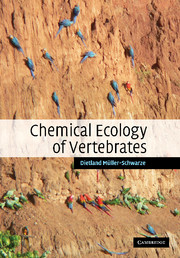Book contents
- Frontmatter
- Contents
- Preface
- Acknowledgements
- 1 The odorsphere: the environment for transmission of chemical signals
- 2 Properties of vertebrate semiochemicals
- 3 Odor production and release
- 4 Chemical cues in orientation and navigation
- 5 Chemoreception
- 6 Signaling pheromones I: discrimination and recognition
- 7 Signaling pheromones II: sex and alarm pheromones and evolutionary considerations
- 8 Intraspecific signals: priming pheromones
- 9 Development of intra- and interspecific chemical communication
- 10 Allomones I: chemical defense by animals
- 11 Allomones II: plant chemical defenses against herbivores
- 12 Kairomones and synomones
- 13 Practical applications of semiochemicals
- Glosssary
- References
- Index
12 - Kairomones and synomones
Published online by Cambridge University Press: 23 November 2009
- Frontmatter
- Contents
- Preface
- Acknowledgements
- 1 The odorsphere: the environment for transmission of chemical signals
- 2 Properties of vertebrate semiochemicals
- 3 Odor production and release
- 4 Chemical cues in orientation and navigation
- 5 Chemoreception
- 6 Signaling pheromones I: discrimination and recognition
- 7 Signaling pheromones II: sex and alarm pheromones and evolutionary considerations
- 8 Intraspecific signals: priming pheromones
- 9 Development of intra- and interspecific chemical communication
- 10 Allomones I: chemical defense by animals
- 11 Allomones II: plant chemical defenses against herbivores
- 12 Kairomones and synomones
- 13 Practical applications of semiochemicals
- Glosssary
- References
- Index
Summary
Kairomones (from the Greek kairos, opportune moment, by stealth) are chemical cues from one species that another uses (“spying”). Primarily the receiver of the signal benefits, as in finding prey by odor, or detecting and avoiding predators by chemical cues. Since the cues are available to another species, they are considered “public” signals, in contrast to “private” signals of restricted pheromone systems, intraspecific by definition. Synomones are chemicals that regulate interspecific relationships where both partners benefit.
Section 12.1–12.7 discuss kairomones and Section 12.8 synomones.
Predator–prey interactions
Prey odors used by predators
Fish
Not surprisingly, much research in sharks, skates and rays has focused on the responses of sharks to human body odors. Human blood attracts sharks, while sweat does not, and urine was even slightly repellent (Tester, 1963). Practitioners use whale meat and mixtures of fish meal and fish oils as shark attractants. In both carnivorous and herbivorous bony fish (Osteichthyes) smell deals with prey odors, social odors, and chemical stimuli in homing, and it is mediated by the first cranial nerve, the olfactory nerve. By contrast, taste serves in detection and selection of food and avoidance of toxic food, and it employs the facial, glossopharyngeal, vagal, and hypoglossal nerves.
Numerous experiments with prey extracts have elucidated the stimuli that guide fish in their feeding behavior. These studies showed:
rinses of prey organisms attract predatory fish and release food searching behavior
predators can distinguish rinses of different prey species
fractions of prey rinses also release feeding responses
mixtures of amino acids are also active
[…]
- Type
- Chapter
- Information
- Chemical Ecology of Vertebrates , pp. 338 - 390Publisher: Cambridge University PressPrint publication year: 2006



